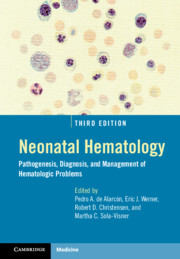Book contents
- Neonatal Hematology
- Neonatal Hematology
- Copyright page
- Contents
- Foreword
- Preface
- Contributors
- Section I Developmental Hematology
- Section II Bone Marrow Failure and Immune Disorders
- Section III Erythrocyte Disorders
- Section IV Platelet Disorders
- Section V Leucocyte Disorders
- Chapter 16 Eosinophils and Neutrophils
- Chapter 17 Functional Phagocyte Disorders in the Neonate
- Section VI Hemostatic Disorders
- Section VII Neonatal Transfusion Medicine
- Section VIII Neonatal Oncology
- Section IX Miscellaneous
- Index
- Plate Section (PDF Only)
- References
Chapter 17 - Functional Phagocyte Disorders in the Neonate
from Section V - Leucocyte Disorders
Published online by Cambridge University Press: 30 January 2021
- Neonatal Hematology
- Neonatal Hematology
- Copyright page
- Contents
- Foreword
- Preface
- Contributors
- Section I Developmental Hematology
- Section II Bone Marrow Failure and Immune Disorders
- Section III Erythrocyte Disorders
- Section IV Platelet Disorders
- Section V Leucocyte Disorders
- Chapter 16 Eosinophils and Neutrophils
- Chapter 17 Functional Phagocyte Disorders in the Neonate
- Section VI Hemostatic Disorders
- Section VII Neonatal Transfusion Medicine
- Section VIII Neonatal Oncology
- Section IX Miscellaneous
- Index
- Plate Section (PDF Only)
- References
Summary
In addition to quantitative neutrophil abnormalities, innate immunity, and thus risk of infection in a neonate, may be negatively impacted by qualitative phagocyte defects. The term phagocyte stems from the Greek “phagein” meaning “to eat or devour” and “cyte” meaning “cell” and refers to hematopoietic derived cells, namely monocytes, macrophages and neutrophils capable of engulfing and digesting microorganisms, foreign particles, and cellular debris. Neutrophils are also classified as granulocytes, given the characteristic presence of granules in their cytoplasm that play a key role in neutrophil function.
- Type
- Chapter
- Information
- Neonatal HematologyPathogenesis, Diagnosis, and Management of Hematologic Problems, pp. 279 - 292Publisher: Cambridge University PressPrint publication year: 2021



